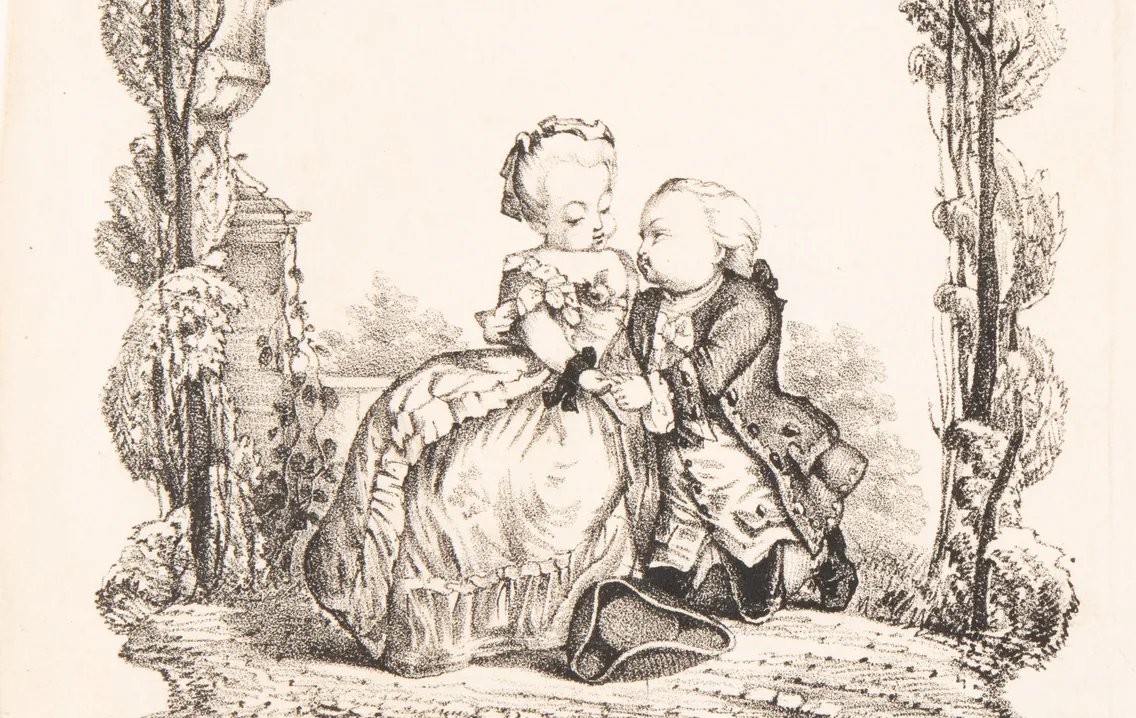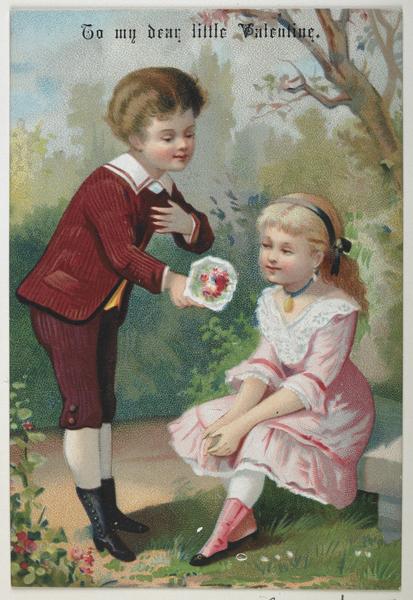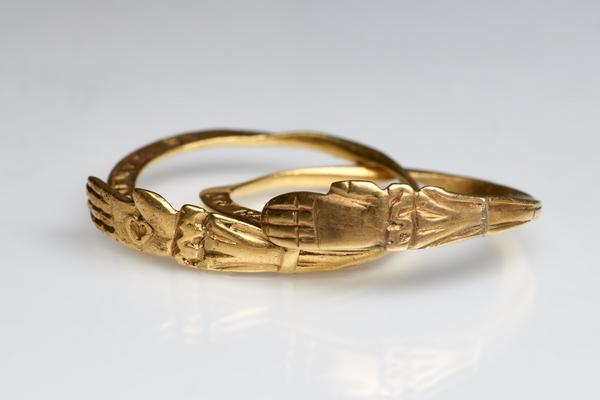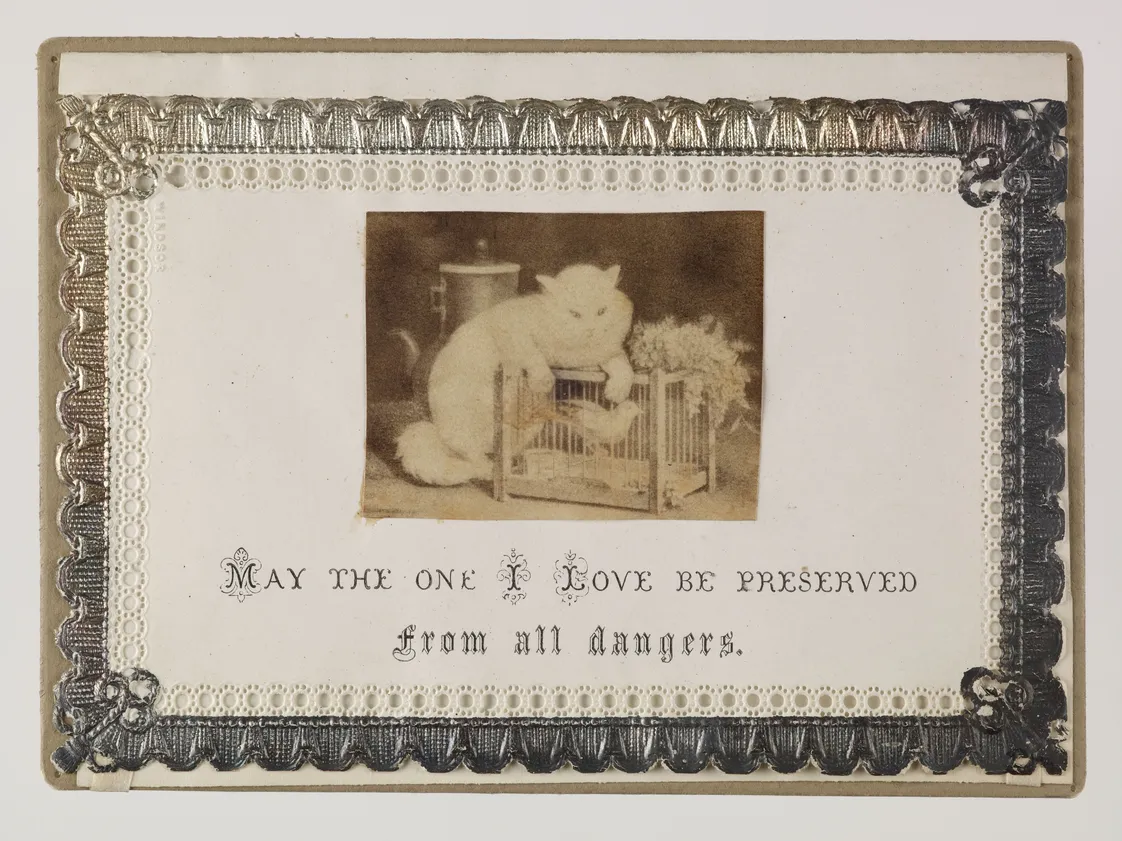21 February 2022 — By Shruti Chakraborty
Valentine's love tokens: From bent coins to whale’s tooth
Love can be strange, and sometimes, so can tokens of love. We spotlight some quirky ‘love tokens’ with an element of craft – some romantic and some practical.
The act of presenting a token of love to the person of one’s affection has been around for probably as long as human relationships. Around the world and across time, we can find interesting proposal rituals rooted in local traditions. Some evolve over time, others fade away and/or become commercial crafts representative of a long-forgotten tradition.
As we look through museum collections, choosing ‘love tokens’ with an element of craft, which have both a sense of romanticism (of creating something with one’s own hands) and practicality (spoons, stay busks or ironing boards).
Bent/bowed/crooked coins

A post-medieval silver penny of Charles I, probably bent to form a love token, dating between 1625–1649.
In Britain, the practice of giving ‘love tokens’ has been around from at least Roman times – if not much earlier – says Senior Curator (Post-Medieval) Hazel Forsyth. Excavations and mudlarking expeditions on the Thames’ foreshore have often uncovered bent or bowed coins from 16th century onwards. Breaking of gold and coins were often included as part of the marriage ceremonial contract, writes Loreen Giese in Courtships, Marriage Customs, and Shakespeare’s Comedies (2006), but ardent suitors would often bend the coins and present them to the lady they wished to court as a symbol of the strength of their love, affection and intent.
Even though clipping, defacement and other wilful damage of coins was a treasonable offense, it didn’t always deter ardent lovers. It has been surmised that many of the ‘crooked coins’ found on the banks of the River Thames – most surviving ones are the 17th and 18th centuries – carry legacies of unrequited love. Often, the head of the monarch would be rubbed clean and initials of the giver or/and the intended would be engraved. Some of those accepted would even be worn as a pendant or incorporated into jewellery to be worn close to one’s person.
Leaden hearts or convict tokens
Around the 19th century, such love tokens/coins took on an additional meaning as they “were created by convicted Britons before they were transported to Australia,” writes Michele Field in Convict Love Tokens (1998). Smoothed coins engraved with affectionate messages were gifted to loved ones by convicts awaiting execution and transportation. These mementos of affection were often known as ‘leaden hearts’.
Among the ones in the museum’s collection, there is one inscribed: “George Wright born May 27th 1806 Aged 20 years to Ann Lee”; “In my dismal cell I lie, In sorrow grief and woe, For my time it seems so long, My doom I wish to know.”
Close to the bosom, literally in the underwear
Another interesting love token usually carved at sea were whalebone corset or stay busks. These were often engraved and decorated by sailors on a whaling ship. This art form – known as pictorial scrimshaw – began in the early 19th century as a leisure activity for whalers who were often at sea for years. Traditionally, the whalers used sailing needles to etch decorations and inscribe messages on walrus tusks, whale teeth and bones and then fill in the scratches made on the ivory and bone with black ink.
“A man would inscribe the busk with coded sentimental images for his beloved… But likely the thought of its proximity to her undergarments – and therefore, her naked body – gave the gift a sense of physical as much as emotional intimacy,” writes Lisa Hix in Collectors Weekly. These stay busks were inserted into the front of stays or corsets to flatten the wearer’s stomach.
Whale's tooth: A maritime love token

This sperm whale tooth has been carved as a gift, given by Alexander Munro to Sophia Knight, probably as a love token. The inscription reads 'Taken from the jaw of a Sperm Whale captured by the bow boat of the Ship Foxhound / Presented by Alexander Munro to Sophia Knight / Sept 30th 1837'.
Another example of a carved scrimshaw love token in the museum’s collection is a carved sperm whale tooth. One side depicts a whaling ship, the other an inscription. The silver mounts bear the hallmark of renowned silversmith Benjamin Smith III, indicating the sailor who owned it had a successful voyage, as whaling profits were divided by seniority.
Interestingly, the sperm whale tooth is a traditional Fijian token of love and marriage. Grooms would present a tooth to the bride’s family when seeking permission to marry. Jewellery made from whale teeth, such as necklaces, are also considered auspicious gifts in Fiji.
Lovespoons: Carved expressions of love

The symbols carved on the lovespoons would convey the intent of the suitor presenting the spoon. This love token has a wheel in the centre and soul symbols at base of handle. Three Christian crosses are placed just above bowl and repeated at top, and the upper wheel/circle features four small hearts.
Long before store-bought gifts of love became popular, suitors had to polish their craft skills because just to propose – in certain cultures – one had to be adept at wood carving. A popular example in the UK is the Welsh lovespoon. Such objects are collectively called ‘treen’, derived from the old Middle English ‘treowen’, meaning literally ‘of a tree’.
While London Museum has a couple of apple corers or cheese scoops with engraved initials that could be love tokens, lovespoons such as those on display at the National Museum Wales, are examples of a custom, wherein the suitor would present a carved lovespoon to a woman expressing his affection and intent (such as heart for love, a wheel for loyalty, lock for protection, etc). His suit was successful only if the woman accepted the gift. One of the earliest known surviving examples of these intricately carved, symbolic lovespoons dates back to the mid-17th century.
Mangletre: Ironing the love in

A mangle board/mangletre, dated 1799.
In Norway, suitors once used a unique ‘treening’ tradition to court women. Conservation Manager Jannicke Langfeldt describes the custom of gifting an ornately carved mangletre – a wooden plank used with a rolling pin to smooth linen. Dating back to the 16th century, these beautifully decorated boards often featured folk symbols and horse-shaped handles, common in Scandinavian woodcarving.
The courtship ritual was simple yet poignant: a suitor would place a mangletre on his beloved’s doorstep. If she brought it inside, it signalled acceptance of his proposal. However, if the board remained outside for over a day, it meant rejection.
Love through a fine-toothed comb

A woman from India’s Muria tribe wearing hand-carved combs, traditionally gifted by suitors.
Journey from northern Europe to central India, where wooden combs once held romantic significance. Until the mid-20th century, boys from the Muria tribe in Chhattisgarh carved intricate designs on combs to gift to their beloved, or "motiari." Girls adorned their hair with these combs, sometimes wearing multiple to indicate several admirers.
According to craft expert Mushtak Khan of Sahapedia, when a girl was ready for marriage, she would present her chosen suitor's comb to her parents. The fate of the unchosen combs remains a mystery. Today, these once-cherished tokens of affection are mostly found in shops as traditional craft items.
Do you know of other similar love customs? Share them with us on social media, tagging @LDN_Museum. We’d love to hear from you.
Shruti Chakraborty is Digital Editor (Content) at London Museum.














